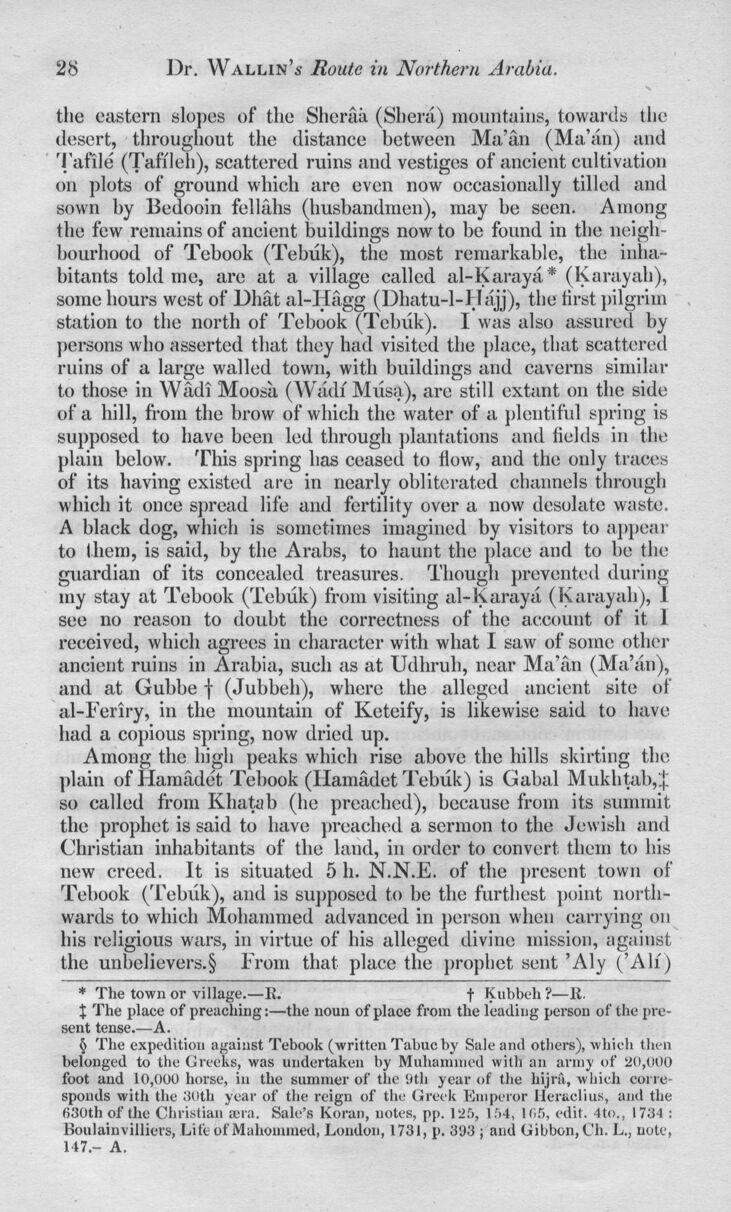
Full resolution (JPEG) - On this page / på denna sida - Route in Northern Arabia

<< prev. page << föreg. sida << >> nästa sida >> next page >>
Below is the raw OCR text
from the above scanned image.
Do you see an error? Proofread the page now!
Här nedan syns maskintolkade texten från faksimilbilden ovan.
Ser du något fel? Korrekturläs sidan nu!
This page has never been proofread. / Denna sida har aldrig korrekturlästs.
[-28-]{+Dr. Wallin’*- Route in Northern Arabia.
28+}
the eastern slopes of the Sheraa (Sbera) mountains, towards the
desert, throughout the distance between Ma’an (Ma’an) and
Tattle (Tafileh), scattered ruins and vestiges of ancient cultivation
on plots of ground which are even now occasionally tilled and
sown by Bedooin fellahs (husbandmen), may he seen. Among
the few remains of ancient buildings now to he found in the
neighbourhood of Tcbook (Tebuk), the most remarkable, the
inhabitants told me, are at a village called al-Karaya* (Karayah),
some hours west of Dluit al-Hagg (Dhatu-l-Hajj), the first pilgrim
station to the north of Tehook (Tehuk). I was also assured by
persons who asserted that they had visited the place, that scattered
ruins of a large walled town, with buildings and caverns similar
to those in Wadi Moosa (Wadi Musa), are still extant on the side
of a hill, from the brow of which the water of a plentiful spring is
supposed to have been led through plantations and fields in the
plain below. This spring has ceased to flow, and the only traces
of its having existed are in nearly obliterated channels through
which it once spread life and fertility over a now desolate waste,
A black dog, which is sometimes imagined by visitors to appear
to them, is said, by the Arabs, to haunt the place and to lie the
guardian of its concealed treasures. Though prevented during
my stay at Tehook (Tehuk) from visiting al-Karaya (Karayah), 1
see no reason to doubt the correctness of the account of it 1
received, which agrees in character with what I saw of some other
ancient ruins in Arabia, such as at Udhruli, near Ma’an (Ma’an),
and at Gubbe f (Jubbeli), where the alleged ancient site of
al-Feriry, in the mountain of Keteify, is likewise said to have
had a copious spring, now dried up.
Among the high peaks which rise above the hills skirting the
plain of Hamadet Tehook (llamadet Tebuk) is Gabal Mukhtab,;j;
so called from Khatab (he preached), because from its summit
the prophet is said to have preached a sermon to the Jewish and
Christian inhabitants of the land, in order to convert them to his
new creed. It is situated 5 h. N.N.E. of the present town of
Tehook (Tebuk), and is supposed to he the furthest point
northwards to which Mohammed advanced in person when carrying on
his religious wars, in virtue of his alleged divine mission, against
the unbelievers.§ From that place the prophet sent ’Aly (’All) *
* The town or village.—R. f Kuhbch?—K.
J The place of preaching:—the noun of place from the leading person of the
present tense.—A.
( The expedition against Tehook (written Tabucby Sale and others), which then
belonged to tbe Greeks, was undertaken by Muhamnied with an army of 20,000
foot and 10,000 horse, in the summer of the fttli year of the hijrii, which
corresponds with the 30th year of the reign of the Greek limperor Heraclius, and the
630th of the Christian an a. Sale’s Koran, notes, pp. I 25, 154, 165, edit, lto., 1734 :
Boulainviliievs, Life of Mahoinmed, London, 1731, p. 393 ; and Gibbon,Cli. L., note,
147.- A.
<< prev. page << föreg. sida << >> nästa sida >> next page >>